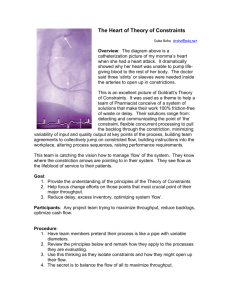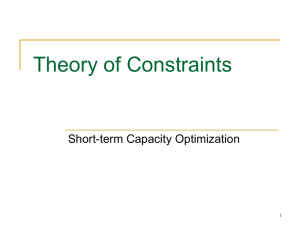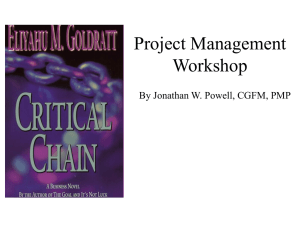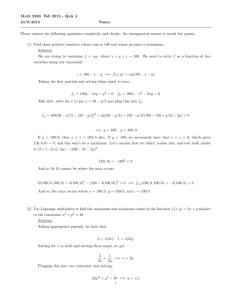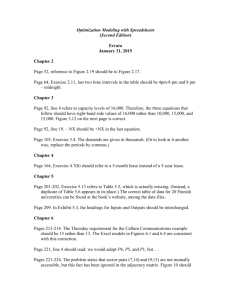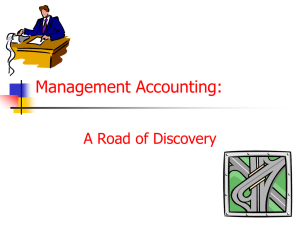Challenge Your Thinking on Theory of Constraints (TOC) Accounting
advertisement
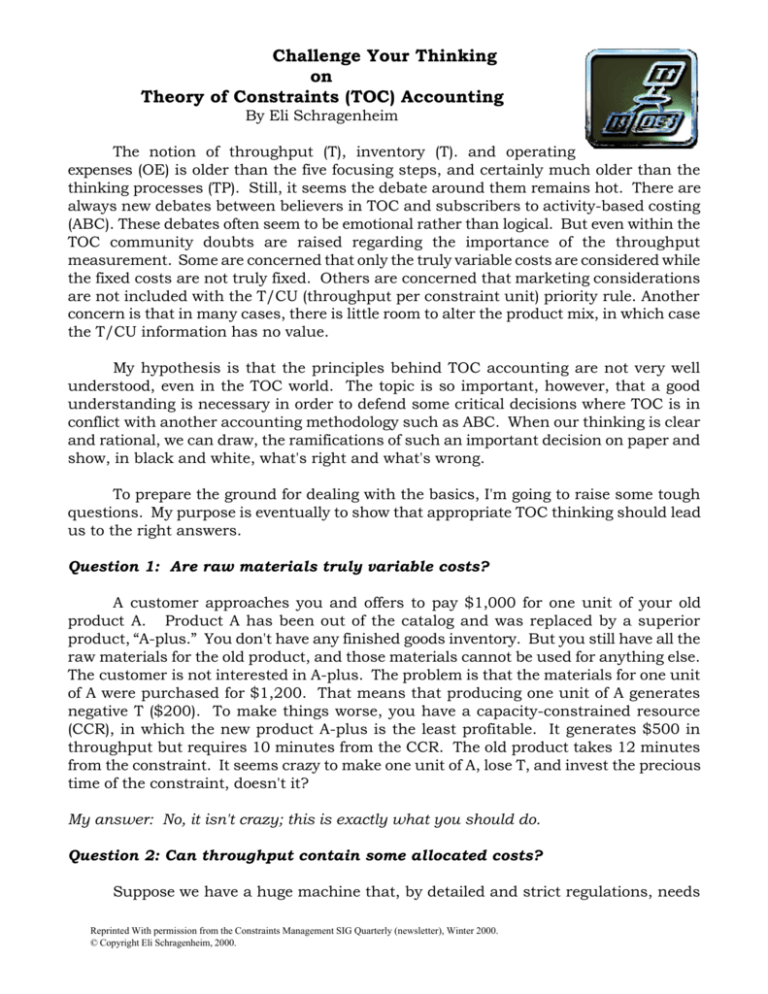
Challenge Your Thinking on Theory of Constraints (TOC) Accounting By Eli Schragenheim The notion of throughput (T), inventory (T). and operating expenses (OE) is older than the five focusing steps, and certainly much older than the thinking processes (TP). Still, it seems the debate around them remains hot. There are always new debates between believers in TOC and subscribers to activity-based costing (ABC). These debates often seem to be emotional rather than logical. But even within the TOC community doubts are raised regarding the importance of the throughput measurement. Some are concerned that only the truly variable costs are considered while the fixed costs are not truly fixed. Others are concerned that marketing considerations are not included with the T/CU (throughput per constraint unit) priority rule. Another concern is that in many cases, there is little room to alter the product mix, in which case the T/CU information has no value. My hypothesis is that the principles behind TOC accounting are not very well understood, even in the TOC world. The topic is so important, however, that a good understanding is necessary in order to defend some critical decisions where TOC is in conflict with another accounting methodology such as ABC. When our thinking is clear and rational, we can draw, the ramifications of such an important decision on paper and show, in black and white, what's right and what's wrong. To prepare the ground for dealing with the basics, I'm going to raise some tough questions. My purpose is eventually to show that appropriate TOC thinking should lead us to the right answers. Question 1: Are raw materials truly variable costs? A customer approaches you and offers to pay $1,000 for one unit of your old product A. Product A has been out of the catalog and was replaced by a superior product, “A-plus.” You don't have any finished goods inventory. But you still have all the raw materials for the old product, and those materials cannot be used for anything else. The customer is not interested in A-plus. The problem is that the materials for one unit of A were purchased for $1,200. That means that producing one unit of A generates negative T ($200). To make things worse, you have a capacity-constrained resource (CCR), in which the new product A-plus is the least profitable. It generates $500 in throughput but requires 10 minutes from the CCR. The old product takes 12 minutes from the constraint. It seems crazy to make one unit of A, lose T, and invest the precious time of the constraint, doesn't it? My answer: No, it isn't crazy; this is exactly what you should do. Question 2: Can throughput contain some allocated costs? Suppose we have a huge machine that, by detailed and strict regulations, needs Reprinted With permission from the Constraints Management SIG Quarterly (newsletter), Winter 2000. © Copyright Eli Schragenheim, 2000. extensive maintenance every 500 hours. Every time such maintenance is done, it costs $25,000 for the parts and the work to be done by an external company. You spent a lot of time convincing management to go into TOC. Now the controller demands that the cost of maintenance should be allocated to every product passing through the machine. He claims every hour on the machine costs $50. How do you convince the controller he is wrong? My answer: The controller is absolutely right. Question 3: What is the role of the order size in the decision-making? What additional information is crucial when a large decision is considered? A very large new client is ready to make a deal. The client knows we have a capacity constrained resource called “M10” that is working three shifts, seven days a week. The client is ready to commit to 50 percent of M10's time at $10 per minute of the CCR’s time, plus all the truly variable costs of the products it decides to buy. Our least-profitable product generates only $8 per minute, but many of our products yield more than $10 per M10 unit. The good news is that the marketing manager says we can give up our least-profitable product and not lose the market for our very profitable products. Do we need more information to make up our mind? My answer: Yes, some information is definitely missing. Someone has suggested buying another M10 for an investment of $3 million. Hiring two additional operators would cost $120, 000 per year. Is at a good investment? It may be great investment, but some critical information is still missing. TOC Accounting: The Basics Were you surprised by my answers? To nay mind, they are all directly derived from the TOC basic concepts. Let's state two basic TOC concepts: # We consider the organization as a whole, which is distinct from the sum of the parts. # Very few variables—maybe only one—limit the performance of any organization at any given time. When we speak about the throughput generated by- a specific action, we actually mean )T—the difference in the total T generated by the organization as a whole. This is the meaning of the holistic approach. In many cases, a deal that generates a certain amount of T will have a different impact on the total T because we may lose or gain T from other products that are indirectly affected by that deal. (We should add that )OE and )I also refer to the whole organization.) The second concept is important because it tells us not only that every organization has a constraint, but also that the rest of the organization must have excess capacity. Throughput is tile rate at which the organization generates “goal units.” For a Reprinted With permission from the Constraints Management SIG Quarterly (newsletter), Winter 2000. © Copyright Eli Schragenheim, 2000. profit-making organization, throughput is the revenue minus the truly variable costs. I also like the description of T as the added value created by the organization. Any truly variable expense cannot be a part of the added value of the organization, as it is value added by someone else. Question 1 shows that seeing raw materials as variable cost is not always valid. If the materials for the old product are useless to the company and there is no way to make money out of them, they are in fact obsolete. Hence, the throughput of producing one unit of product A is equal to the revenue—$1,000—built from materials with no value. Since generating this amount of throughput requires 12 minutes, we get $83.33 per one minute of the constraint (T/CU). The new product, A-plus, generates only $500/10, or $50. Certainly, we get much more T from the old product than from the new one. Question 2 also involves the interpretation of throughput. Are maintenance expenses truly variable? In this case, I think they are. Every hour on the machine is counted. If we refrain from working one hour on the machine, the maintenance will not be done until that hour is actually used. One may argue that 500 run hours, in reality; is not a precise figure. Still, I claim that working an hour causes a certain amount of maintenance. Should we always treat maintenance as part of the T? I prefer to leave this issue to the readers. It is not a very important one, but we can all sharpen our minds by asking the question. Question 3 is of special importance, as it tackles a hidden assumption behind the T/CU priority rule. We can easily calculate the T/CU of a very large order and compare it to a one-unit sale of one product. Can we really do it? Let us check again the rationale behind T/CU. What we expect is that every sale will eventually add to the bottom line. That means that )T – )0E > 0. Both T and OE refer to the whole organization and how it looks both now and in the future. Now, it seems frightening to consider the additional T and OE for the whole organization. So we would like a simpler rule to quickly assess whether )T – )OE > 0. Fortunately, TOC can provide this for us in certain cases. Here are the four necessary conditions for the T/CU rule to be applicable: 1. We have one—and only one—capacity-constrained resource. 2. The market demand, and our influence on the demand, is such that for any additional load we consider putting on the constraint, we can effectively free an equivalent amount of load from the existing market. 3. The order (deal) under consideration will not change the location of the current constraint. 4. The order does not add any OE. Reprinted With permission from the Constraints Management SIG Quarterly (newsletter), Winter 2000. © Copyright Eli Schragenheim, 2000. Under these conditions, when we consider order X, which generates N throughput units and requires M constraint units, the ratio T/CU—in this case N/M—is a measure for relative desirability. When we accept the order, we get additional N to our total T, but we have to give up something else. Suppose the least desirable of our current market produces N1 throughput units for the same M constraint units. Then the true )T is (N – N l). If all the sales from the least desirable take less than M constraint units, we need to go to the next-least desirable and produce less of that product. We can conclude that if we accept the order and do all necessary, adjustment, as long as the order yields a ratio that is higher than the remaining least desirable, this is a good order to accept. Otherwise, it is not. When we have a large deal, like the one above, if there are doubts whether conditions 2 and 3 apply, we can be almost certain that condition 4 does not apply. So, we go back to the )T – )OE > 0 rule. We know the )T is generated directly from the deal. The CCR works 24 hours a day, 360 days (1 assume there are 5 or 6 special days) a year, producing 518,400 minutes of work. The deal leases 50 percent of these, or 259,200 minutes. At $10 every minute, the deal generates a total of $2,592,000 of T. One of the missing information items is how much T we lose because we have 50 percent less constraint's time for our regular market. It is not enough to know the current least-desirable product, since it may require much less than 50 percent of the constraint's time. But that is only one piece of missing information. It is even more critical to know whether the product mix the client has in mind will change the constraint! A different use of 50 percent of the current constraint may change the product mix to the point that we have interactive constraints or, worse, the emergence of a real bottleneck. This is also the critical missing information needed to evaluate the suggestion to elevate the constraint by buying another machine. We need to know how all the rest of the system will respond to an additional 50 percent load on the current constraint. We may find out that to keep the constraint in place, we need to invest more money and accept much higher OE. Hence, we need to evaluate the )I and compare it to )T – )OE. This is what TOC accounting is all about—directing us to the critical information for good decision-making. Eli Schragenheim as the author of the recently released book, Management Dilemmas, and co-author (with Bill Dettmer) of Manufacturing at Warp Speed, due from St. Lucie Press in September 2000. He is a consultant for the implementation of TOC in a wide variety, of organizations. Providing learning for management is an integral part of his work. To order your copy of Management Dilemmas, call APICS Customer Service at (800) 444-2742 and ask for stock #03751 ($16.95 member and $19.95 nonmember). Or order on-line at www.apics.org Reprinted With permission from the Constraints Management SIG Quarterly (newsletter), Winter 2000. © Copyright Eli Schragenheim, 2000.
